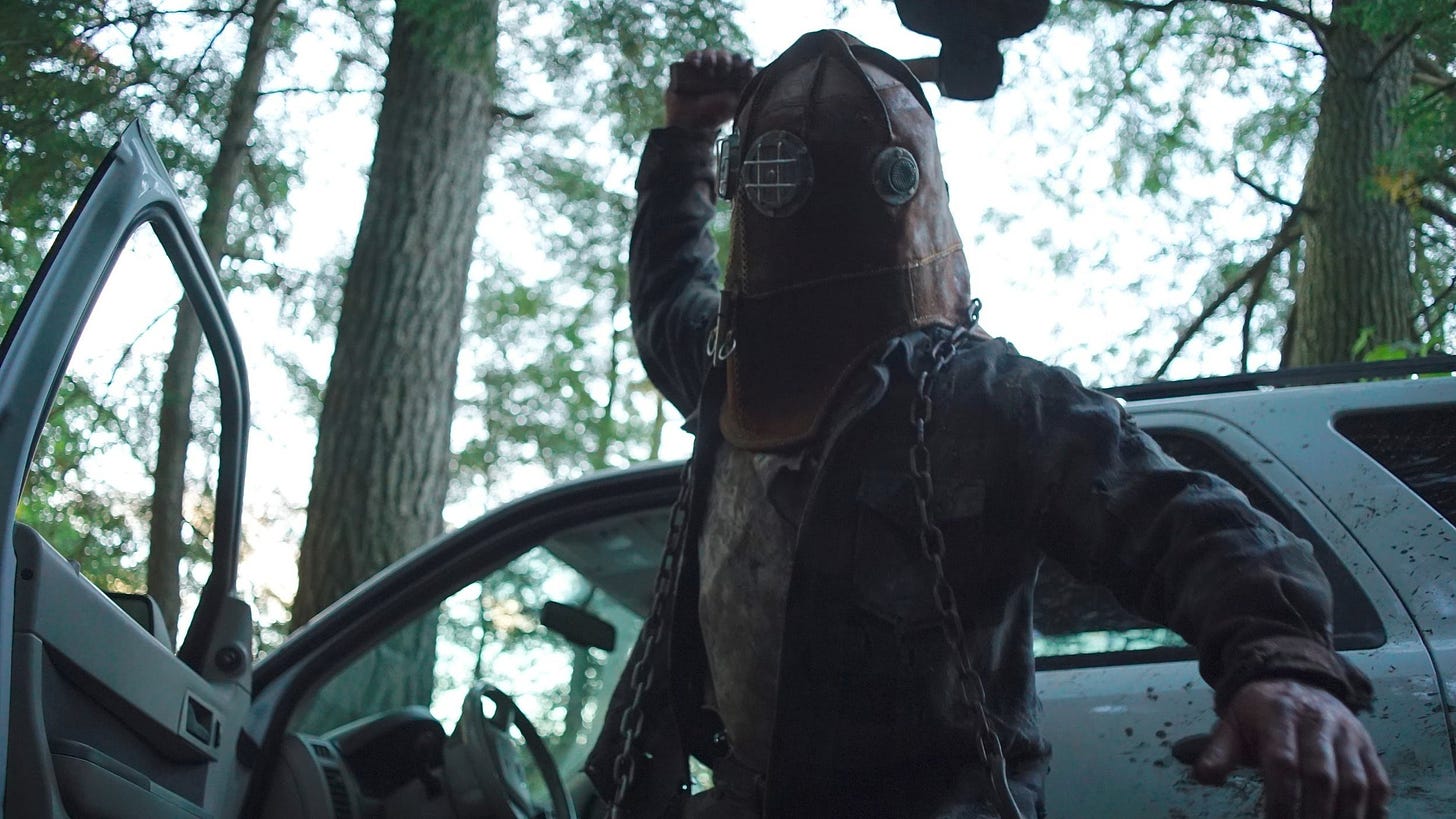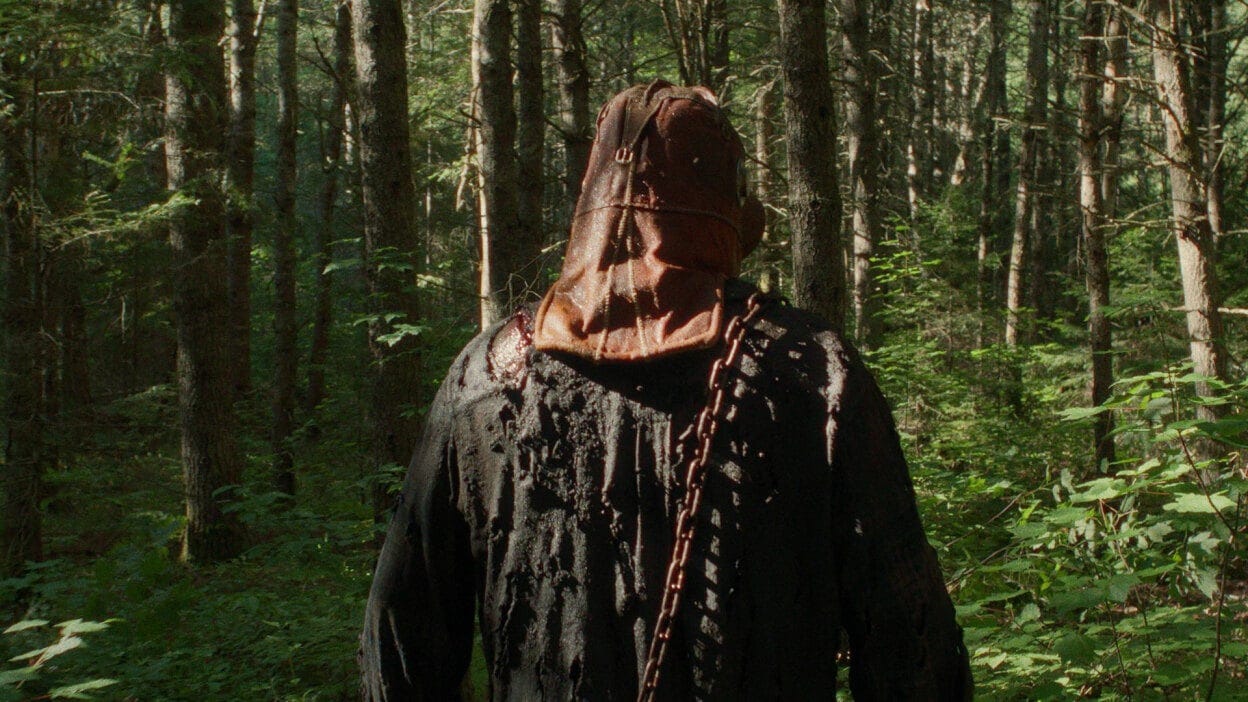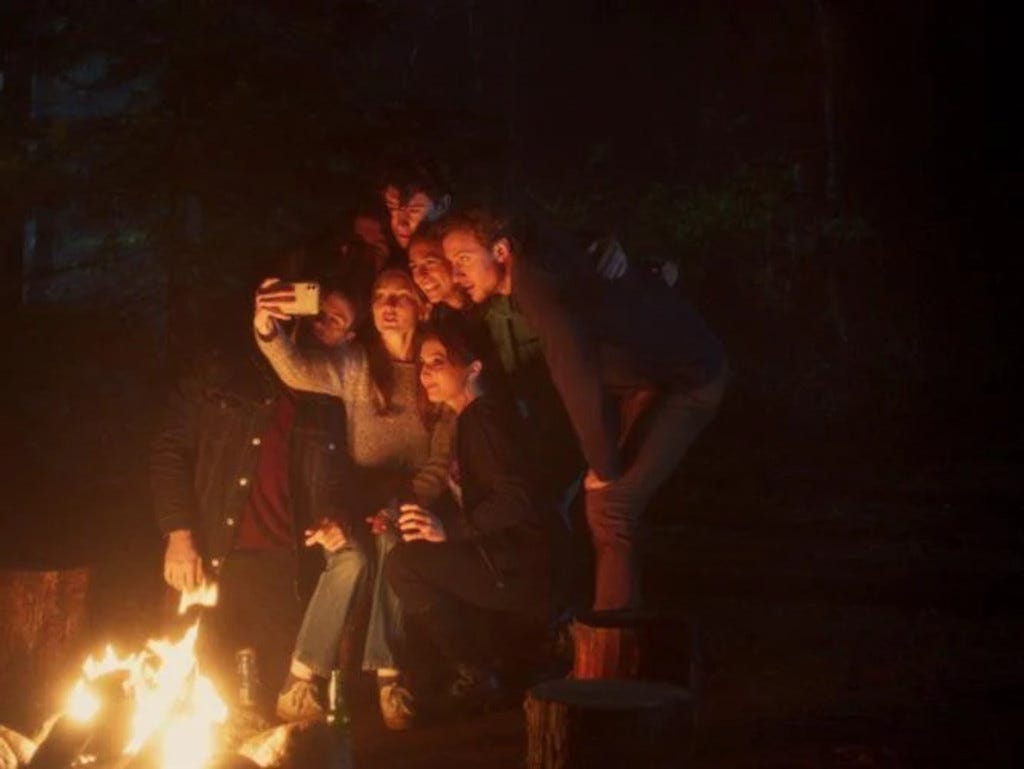‘In a Violent Nature’ and Committing to The Bit
This unusual slasher film loses steam when it loses faith in its own conceit.
NEW STANDARD DISCLAIMER: This newsletter aggressively spoils things.
The slasher subgenre of horror movie is a perfect organism, when grown correctly in the right lab. All it takes are four essential ingredients: A slasher (weird, half-baked origin story optional), some victims (preferably smug assholes accompanied by at least one sensible girl who will be the Final Girl), a remote and ominously empty setting1, and gratuitous violence.
The simplicity of that setup does encourage repetition and boredom sometimes. The interesting stuff often happens in the margins—in the physicality of the slasher, the pitch of the screaming2, and the way the setting is filmed. No two slasher films are exactly alike, but it can sure seem that way.
In a Violent Nature is a film written and directed by Chris Nash. In a sense it is a riff on classic 1970s and 1980s slasher films: A group of young people camping in a remote area are slaughtered by a relentless, immortal killer who is endlessly avenging wrongs done to him in life, with the kids’ own actions being the instigating event of the story. But Nash introduces one change to the formula that instantly makes In a Violent Nature 1000% more interesting: Most of the film is hooked to the slasher’s perspective, instead of the victims3. And as long as he sticks with that, the film is terrific.
If You Go Into the Woods Tonight
At the beginning of the film, a group of unseen youths discover a golden necklace hanging from an old, crumbling fire tower. Against advice (and, if you’ve ever seen a slasher film once in your life, common sense4), one of the kids takes the necklace as the group walks away. Instead of following the group, the camera stays, and soon a hulking, scarred figure (our killer, played by Ry Barrett) emerges from a grave under the fire tower, pulling himself up from the dirt.
And then the camera stays with him.
In just about any other slasher film, the camera would linger with the victims. We’d follow their inane conversations so we know which ones are the assholes whose deaths won’t bother us much and which ones are the semi-good ones who we will root for. We’d be treated to shots of hot bodies in underwear and some sexy times5, and much of the story’s tension would be centered on wondering where and when the killer will strike. There would be jump-scares and misdirections to keep us on our toes, but the thought would be omnipresent: The killer is out there.
In In a Violent Nature, however, we stay with the killer. Shot mostly from behind, we follow as he walks through the forest—implacable, silent, steady. The world around him is calm and peaceful—birds sing, twigs snap, the wind blows. These shots go on for a long time, and the rhythm of the sound design is stellar. Eventually, our killer overhears voices, and we get snatches of exposition before he murders someone in the most horrifying way imaginable6, and then move on to the next encounter with us mainly following.
For a while, this is how the film unfolds—we’re tied to the killer’s almost silent perspective, always at a slight remove, and the “story”—the standard cycle of worry, panic, and despair experienced by the kids—is delivered in bits and pieces via overheard conversations and interactions observed from a distance7. And it’s fantastic. Because that stuff is the least interesting aspect of any slasher story—those tropes repeat endlessly. Seeing the hyperfocused process of actually murdering all those people is a lot more fun. The film manages to convey the sheer monotony and inescapable quality of the killer’s mission8.
Have You Heard the Story of Johnny the Much Abused?

Unfortunately, Nash starts hedging his bets early on. First, there’s an extended campfire sequence where we get to meet the aggressively thin and boring characters who will serve as the killer’s prey, as well as hear the sad, tragic back story of our killer, who is apparently named Johnny9. This scene goes on long enough for me to conclude that Nash thinks his characters are actually fun to spend time with, which is an unfortunate misconception10.
And in the final act of the film, the camera suddenly attaches itself to our Final Girl (Andrea Pavlovic) as she makes a final, desperate trek into the forest to escape Johnny. On the one hand, this is a terrific sequence. It mirrors Johnny’s peaceful treks through the woods in search of victims, but for Final Girl the forest is dark and foreboding, the sound design discordant and startling as she stumbles and trips and gets utterly lost in the darkness. The contrast makes things clear: Johnny is nature11. He is violent and deadly but pure. He’s at home in this world. Final Girl isn’t, and will never be, and that’s why her transient, ephemeral life will end so easily12.
On the other hand, suddenly attaching the perspective to this last survivor means we spend the final 20 minutes of the film following her very uninteresting bit. I don’t care what happens to this girl. We see her survive (or not) in every single slasher movie. I want to see what the fuck Johnny is up to, dammit. Once the camera wanders away from him, the film becomes much less interesting13.
Ah, but those sequences following Johnny around as he silently murders people? Genius. If the filmmakers had more confidence in their own gimmick the film would have been a lot more effective.
Sometimes I like to imagine that I am being followed by a secret Truman Showesque camera, and I put a little disco into my walk just in case. Therapist? No, why do you ask?
NEXT WEEK: The Kingsman “Free Bird” scene and saying the quiet part out loud.
If you enjoy this newsletter, consider subscribing to my paid fiction Substack, Writing Without Rules: From the Notebook!
Having been shipped off to Boy Scout camp several times as a child, I am amazed I survived. The Boy Scouts are chock full of weirdos who are serial killer material.
I have little doubt that I would not survive any kind of Friday the 13th-type scenario. I am slow, ungainly, and morally compromised. I’d be dead meat. I’d be the guy everyone notices is missing in the early part of the film but no one feels compelled to search for.
Speaking as someone born to a long line of prey, I totally get it.
Seriously: At this point, aren’t we all essentially the kids in Scream, totally aware of the tropes we’re dealing with? <realizes the “kids” in Scream are all middle-aged now, turns to dust>
Younger folks will never understand how we older folks had to rely on PG-13 and R-rated scenes in movies for our porn. It was a primitive time.
The kills in this movie are gratuitous, which made me glad that the characters are so flat and uninteresting, because if I cared about any of them I would have been traumatized.
As anyone who’s ever overheard a muffled conversation in the next room knows, your imagination is almost always way more interesting than what people are actually talking about.
Like, imagine you disturb an immortal serial killer’s grave, but then you happen to leave the campground suddenly and go back to your life, and the killer just wanders the camp forever looking for you while you live out a life of quiet desperation in Bayonne.
I salute the writers for acknowledging that there’s no upside to giving your character an interesting name.
I have had this misconception about my own company all my life. Is An Unfortunate Misconception the title of my memoir? It works on so many levels!
AND NATURE IS VIOLENT DO YOU GET ITTTTTTTT????
I used to think I was destined for great things. Now I’m kind of amazed I’ve survived this long, considering my whole, you know, vibe.
Much in the same way conversations become much less interesting when we stop talking about me.




